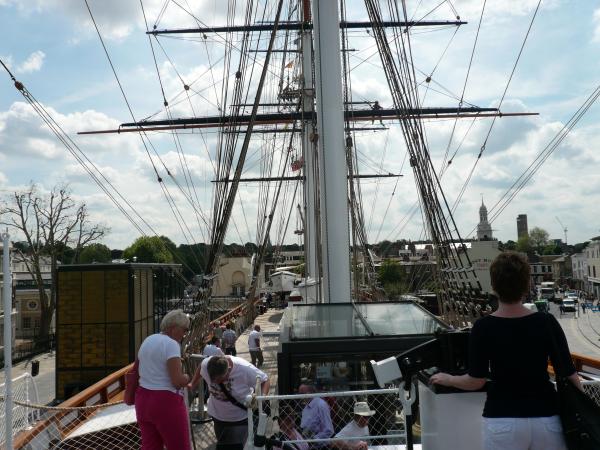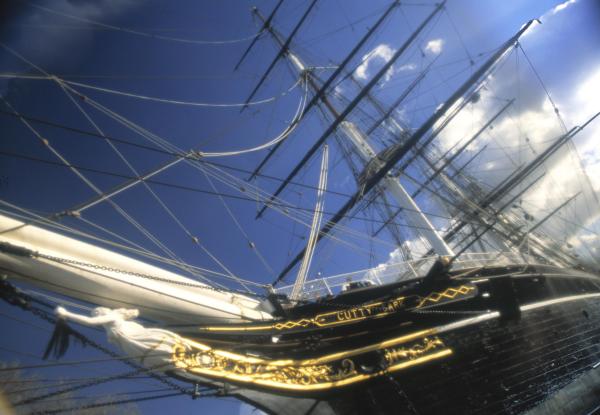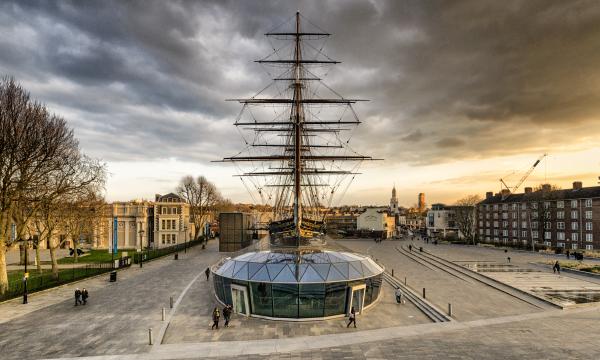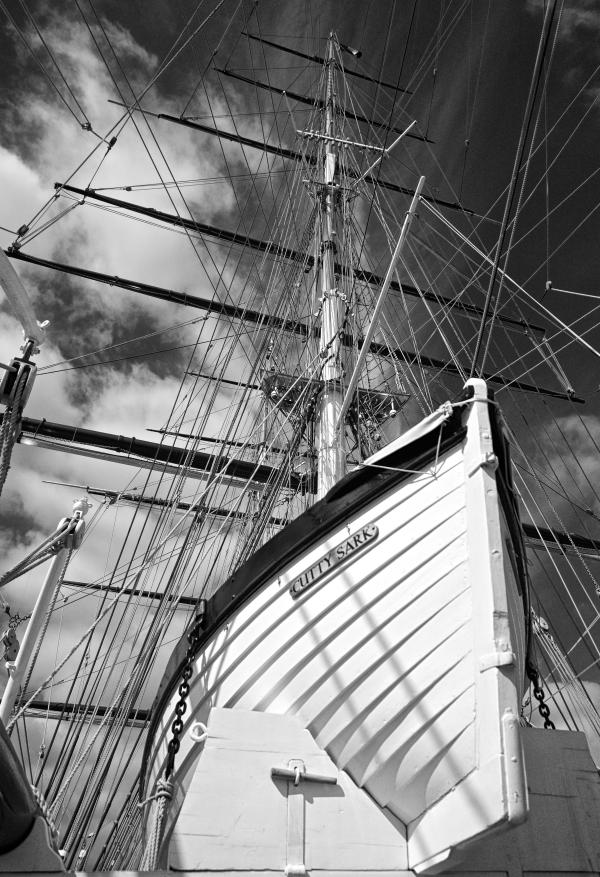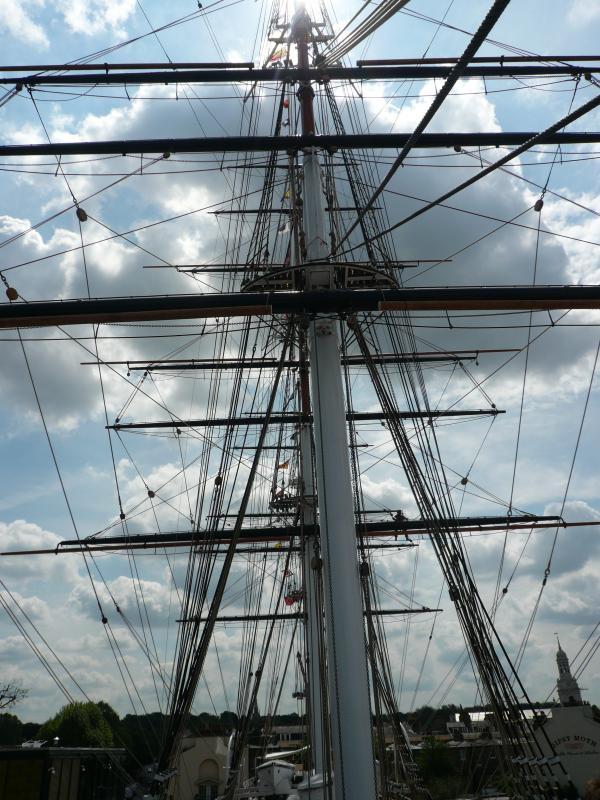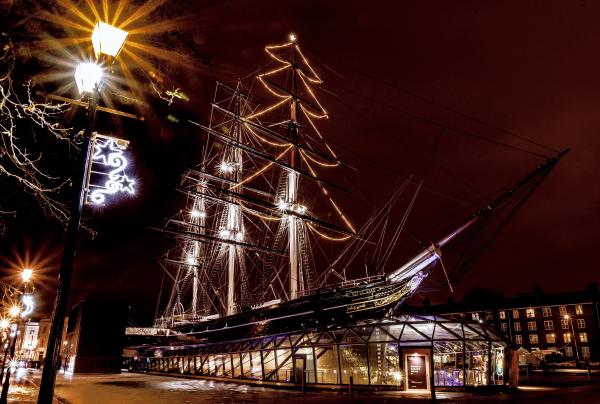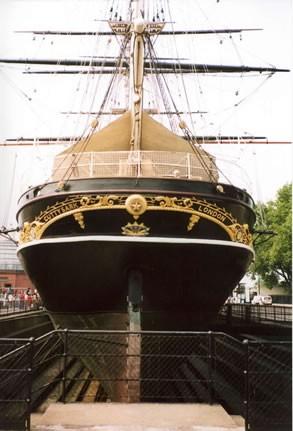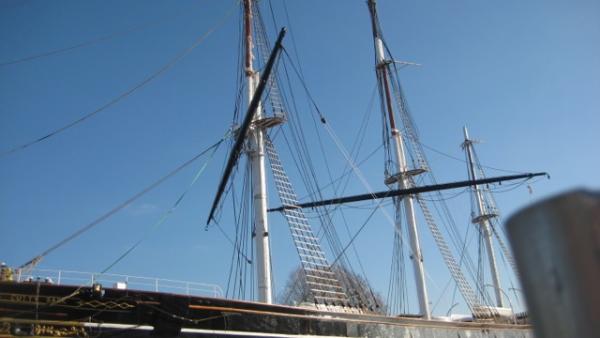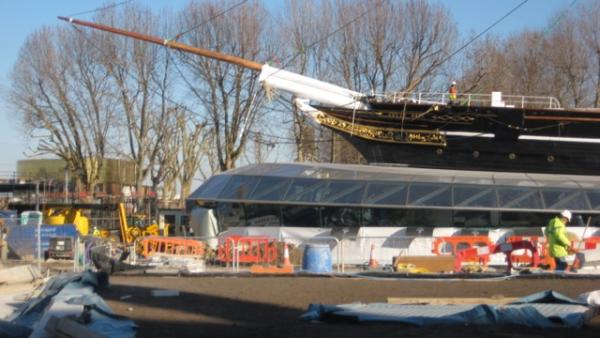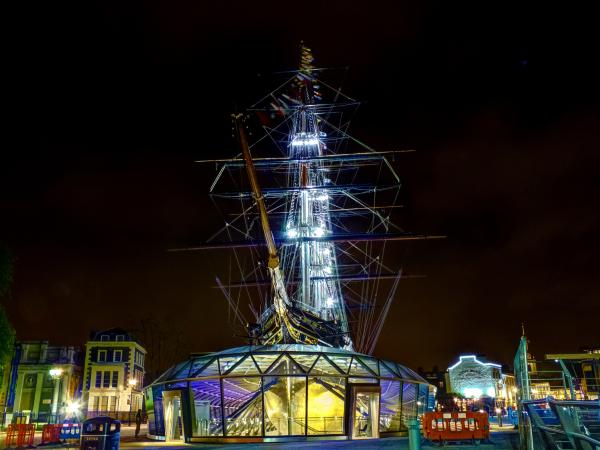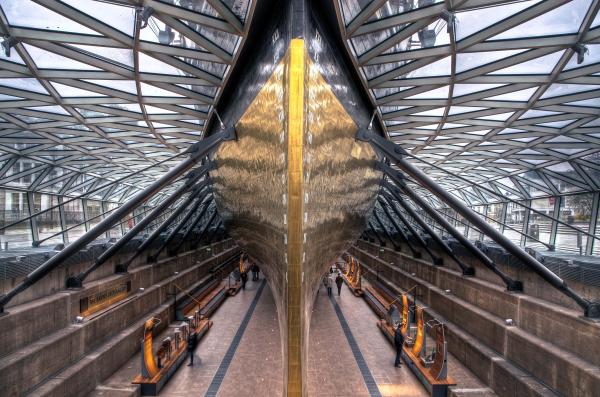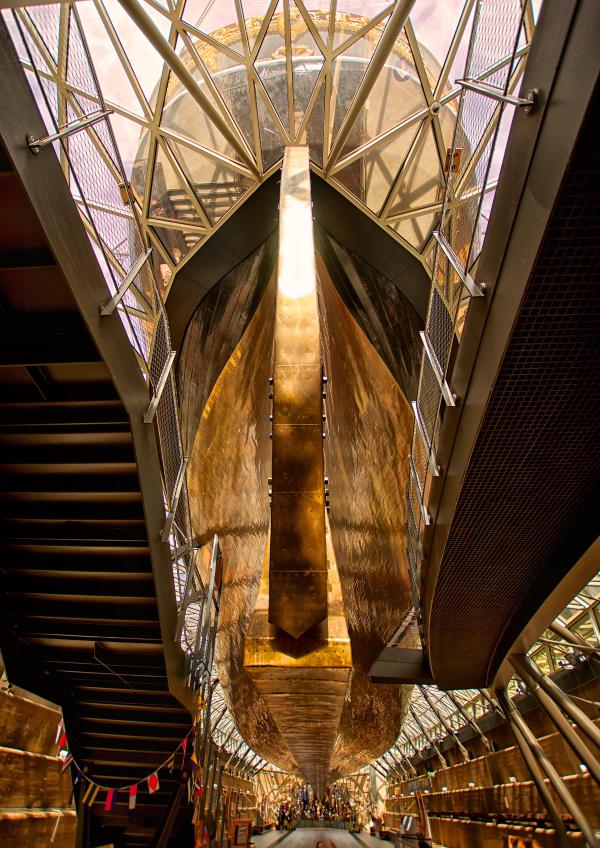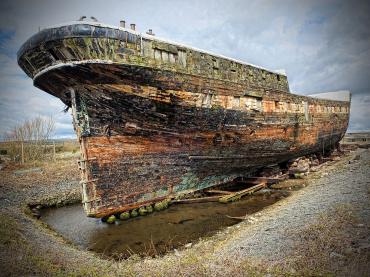

Previous names
- 1895 - 1922 Ferreira
- 1922 - 1923 Maria di Amparo
Details
Construction
Dimensions
History
Built in 1869 by Scott & Linton at Dumbarton, for the original owner John Willis, CUTTY SARK is the sole surviving extreme clipper, designed to be very fast. She was one of the last tea clippers built, but as this trade was taken over by the steamers using the Suez Canal, she turned to general trading including transporting wool from Australia.
CUTTY SARK had been sold in 1895 and renamed FERREIRA, after the Lisbon-based company that bought her. Since then, she had been tramping between the Portuguese colonies in Africa, South America, the southern United States and Portugal.
When FERREIRA arrived in the Mozambique port of Laurenço Marques (now Maputo) in October 1915, Portugal was not officially at war. Nevertheless, it was clear that war was coming – there had already been clashes with German troops in Angola. One part of the preparations was to conscript merchant seamen into naval service. In Laurenço Marques, Captain Frederic Vincenzo da Sousa faced the colonial authorities demanding the transfer of FERREIRA’s entire crew to the Portuguese navy, although he managed to reduce the demand to nine reservists, leaving him with six apprentices, a cook and two foreign sailors. Da Sousa eventually managed to recruit a number of keen but non-seafaring locals and a couple of fishermen, making his crew up to 18. It was too few for a ship of this size but it was all he could muster.
It had taken da Sousa months to assemble this crew and FERREIRA did not sail until late April 1916 (Germany declared war on Portugal the previous month, precipitated by the seizure of German and Austro-Hungarian ships in Portuguese ports). The ship was laden with coal, bound for Mossamedes (now Namibe) in Angola. On 1st May 1916, off the South African coast between Port Elizabeth and East London FERREIRA ran into heavy weather. It gradually worsened until the winds were reaching Force 10. The new seamen were, understandably, terrified and of little use in such conditions. Then the ship rolled right to port, her lower yard arms dipping into the water. And she stayed like that – because perhaps as much as 20 tons of her coal cargo had not been loaded properly and had shifted. With the aid of a single hurricane lantern, the apprentices spent the whole day shovelling the cargo to get the ship back on an even keel. They succeeded but the weather did not improve and, on 3rd May, FERREIRA was again listing to port. Captain da Sousa thought it too risky to attempt to make for the nearest port, Port Elizabeth, so all he could do was to send his apprentices back into the hold once more and to hope that the weather would improve. But it did not and, again and again, the coal shifted. Finally it shifted so much that the Captain knew there was no possibility of levelling her. His only chance of saving the ship was to cut away the masts and rigging. Over the next few days more and more was pitched over the side until all that remained was the foremast and fore-topmast.
On 10th May, the wind finally subsided and, after nine days of wondering if his ship would sink, Captain da Sousa finally felt that, if he could find a ship to tow him, he could reach Cape Town. He managed to make contact with the S.S. KIA ORA, a passenger and cargo steamer, and went aboard to ask for help. Unfortunately KIA ORAwas bound for Sydney, not Cape Town, and her captain was worried about German submarines in the area. He advised da Sousa to scuttleFERREIRA. But the Portuguese captain had come through too much for that. He returned to his vessel. After two more days they were drifting towards Cape Aghulas – the most southerly point of Africa, notorious for its rogue waves -- and almost certain shipwreck, when another steamer came into view. She took FERREIRA under tow into Table Bay, where she arrived on 14th May.
Captain da Sousa’s log identifies the steamer that rescued his ship as the Blue Funnel Line’s INDRAGHIRA. Launched in Glasgow in 1912, this vessel had joined the ‘Blue-Flue’ fleet in 1915 and was, in fact, then known as EURYLOCHUS. Her own fate was to be sunk in 1941 off Sierra Leone by the German auxiliary cruiser KORMORAN.
The insured value of FERREIRA was only £700 – but the estimate to repair the damage from the storm and the loss of her masts and rigging was put at £2,250. Not only that, the war had created a shortage of suitable wood for replacement masts and yards. Therefore the Ferreira company decided to re-rig her not as a ship but as a barquentine, a vessel with square sails on the foremast but fore-and-aft sails on the main and mizzen masts. Not only did this require fewer yards, it also needed fewer men to work the vessel than a full-rigged ship.
Nevertheless, FERREIRA spent the remainder of 1916 and all of 1917 in Table Bay. Finally, in January 1918, she was towed out of the dock… and promptly collided with the quayside, damaging both her stem and her figurehead. But she was finally back at sea and the last year of the war was largely spent peacefully sailing along the west coast of Africa.It was during this time that she made her legendary fast voyages. In 1895 she was sold to a Portuguese company and renamed FERRIERA. She was re-rigged as a barquentine following a dismasting in 1916. Captain Dowman of Falmouth decided she should be preserved and in 1922 bought the ship and made her part of a floating nautical school he was operating.
In 1938, his widow presented the ship to the Thames Nautical Training School at Greenhithe. They maintained the ship until 1952 when the Cutty Sark Preservation Society was formed under the leadership of Frank Carr, Director of the National Maritime Museum, and the patronage of HRH the Duke of Edinburgh. The ship was permanently installed in a stone dry-dock at Greenwich on the Thames, and fully restored to her appearance as an active sailing vessel. In the 1990s, structural problems were first identified in her hull and plans were put in motion for a full restoration. She was awarded a grant of £13 million by the Heritage Lottery Fund and, in November 2006, her rig was dismantled prior to work commencing. On 21 May 2007, a fire broke out onboard CUTTY SARK in the early hours of the morning and was later put out by the London Fire Brigade. The Cutty Sark Conservation Project is a £25 million scheme, not only to preserve the fabric of the ship, but also to ensure that she has a sustainable future. The vessel will be lifted and suspended three metres above her current position, allowing her visitors to walk, dine or dance under her and, for the first time, be able to properly appreciate her beautiful lines. A sophisticated glass 'bubble' meeting the ship at the waterline will give year-round protection to visitors in the dry berth and to the lower hull itself. These new works will be clearly distinguishable so that each visitor knows what is historic and what is not. A new interpretation scheme will be installed to give a more atmospheric, more dramatic sense of life and times of the ship.
Significance
1. What is the vessel’s ability to demonstrate history in her physical fabric?
Evidence for designs, functions, techniques, processes, styles, customs and habits or uses and associations in relation to events and people. How early, intact or rare these features are may impact on significance.
CUTTY SARK has undergone numerous repairs during her lifetime, including conservation work in 1954-1957, and then, following a 1998 survey, a six-year project commencing in 2006. However, she retains the majority of her original wrought iron structure, which comprises 139 iron hull frames, deck beams, stringers, keel plate, box keelson, bilge keelson, side keelson, stanchions and the fore and aft collision bulkhead (openings have been made in the hull for access reasons) making her one of only two surviving composite vessels in the world.
The iron hull frames have survived intact with only a small area of loss behind the aft bulkhead. Significantly the original markers stamp of ‘monkland’ and rating of the quality of the wrought iron as ‘Glasgow best’ (the poorest quality iron) are evident. These frames have been preserved, using modern methods, in their current condition. With 70% of fixing holes wasted below the bilge strake, and 90% of fixing above the bilge strake still usable, the hull planks under the bilge strake have been re-attached to ‘sister frames’ which consisted of new steels inserted in-between the original frames, attached from the bilge strake down to the keel plate. Where frame fixings had wasted away, the original muntz bolts (60:40 copper zinc ratio) fixings remained in the timber planks. Approximately 87% of the vessel’s hull planks are original ‘as built’, being made of teak and rock elm. Fractured planks have been repaired using like-for-like materials before being laminated and treated with epoxy resin.
Her diagonal plates, fitted in pairs at an angle of 45 degrees from her bilge strake to sheer strake, have structurally deteriorated and have been over plated with new mild steel. The original rivets had to be removed to fix the new steels, but most of the original material remains intact. Similarly, 19% of butt plates to which the hull plank ends are attached have completely corroded and been replaced. The bilge strake has been over plated its entire port and starboard length. The floors have corroded substantially and have been treated with new steel support angles. The keel was originally constructed in rock elm, but was replaced circa 1921, with longleaf pine. The fore and aft deadwoods, stern and stem post are all made from teak, with repairs carried out in the same material. The rudder has been lost numerous times over her life and is currently made from teak.
The majority of the iron panelling in the counter and all the rivets have been replaced due to structural failure. A large proportion of the iron bulwarks and flare have been replaced. The topgallant pin rail and wooden bulwark panelling has all been restored with teak, keeping examples of rope marks from her working life. Almost all of the deck furniture, mooring bitts, mooring pipes fairleads, cleats, hawsepipe, cable compressors, eye plates, davits, the majority of the chain plates, deck and brace winches, bilge pump, bowsprit, steering gear, are from her working life. Her windlass, catsheads, heads, anchors, nameboards, billboard, gingerbread, sheathing and majority of her yards, jiboom, stuns’l booms and mast have been replaced since she has been in dry dock. All her concrete ballast has been removed.
Her main cargo hatch still has her Lloyd’s number and tonnage marks. Damage to the ship’s decks after the fire of 2007 meant that the main deck, monkey fo’csle, and poop deck have been newly constructed using modern technology, with a teak laminate on a marine ply base. During the project the 1920s ‘tween deck was removed and replaced with a traditionally constructed deck made from Douglas fir. The forward and aft deck houses were reconstructed in the 1950s, with restoration of the Birdseye maple and teak panelling in the saloon. The Portuguese alterations to the accommodation were left in during the 1950s restoration for ease of visitor flow. The ship has been re-rigged as a square rigged sailing ship, representing her days in the China tea trade. Her running rigging has been replaced with natural rope fibres. A number of adaptations have been made to the hull and decks to facilitate access and interpretation in her role as a museum ship.
2. What are the vessel’s associational links for which there is no physical evidence?
Associations with people or places. Off-ship research.
CUTTY SARK is the sole surviving example of an extreme clipper of the late nineteenth century tea trade. She was built in 1869 on the Clyde in Dumbarton for ship owner Jock ‘white hat’ Willis and has connections to Scottish literary heritage, being named after a witch’s attire in Robert Burns poem ‘Tam O’Shanter’. CUTTY SARK was designed by Hercules Linton and built by Scott & Linton - a relatively new firm, being only the sixth ship they had constructed.
CUTTY SARK was originally built for speed, bringing back the freshest tea from China, which helped to make the beverage popular in the British consciousness. Tea clippers would race to be the first vessel back in London and CUTTY SARK is remembered for a race with her rival, the THERMOPYLAE, in 1872, which saw her lose her rudder off the Cape of Good Hope, arriving home a week later. CUTTY SARK is also associated with the Australian wool trade and, under her famous master Captain Richard Woodget (Master 1885-1895), she had her most successful years setting a record passage of 73 days from Sydney to London. In 1889 she was spotted overhauling the P&O steamship BRITANNIA, noted in the BRITANNIA'S log simply as “sailing ship overhauled and passed us”! CUTTY SARK has clear international links, not only because of her history with the tea and wool trade, but also because of 25 years of operating under the Portuguese flag. In 1895, she was sold to the firm J. Ferreira & Co. and re-named FERREIRA, sailing to ports around the globe with a variety of cargoes, rigged, after 1916, as a barquentine.
Returning to the UK in 1922, CUTTY SARK was restored to her appearance as a tea clipper, she was opened to the public in Falmouth and served as a sail training vessel. In 1938, she was transferred to the Incorporated Thames Nautical Training College at Greenhithe. She participated in the festival of Britain in 1951, which year also marked the founding of the Cutty Sark Preservation Society by National Maritime Museum director Frank Carr, with HRH Duke of Edinburgh becoming patron (a role he remains active in). CUTTY SARK is now on permanent display, as a memorial to the men of the merchant navy who lost their lives in two world wars and is the only vessel in England to have been awarded Grade I listed status.
3. How does the vessel’s shape or form combine and contribute to her function?
Overall aesthetic impact of the vessel, her lines, material she was built from and her setting. Does she remain in her working environment?
CUTTY SARK‘s lines were influenced by past designs, notably the ‘Tweed’, another ship in the Willis fleet. He instructed designer Hercules Linton to build ‘into the midship, attributes of Firth of Forth fishing boats, creating a beautiful new hull shape that was stronger, could take more sail and be driven harder than any other’. She was designed in response to a need for fast ships to compete in the China tea trade and her 963 tonne hull, with its composite construction, gave her the necessary strength and speed to fulfil this demand.
CUTTY SARK has a sharp bow with fine lines, a large sail area and a relatively small cargo carrying capacity. She was built from high quality teak and rock elm attached to a wrought iron frame and her square rig carried 32,000 feet of canvas. Relative to her size, this was a greater sail area than that carried by any other clipper, achieving a top speed of 17.5 knots. CUTTY SARK was built to carry cargo and, on her first voyage, she returned with 1.3 million pounds of tea in her lower hold and ’tween deck, accessed by three cargo hatches for loading.
Her crew quarters originally consisted of senior officers in the Liverpool house, petty officers in the forward deck house, with bunks to accommodate 22 seamen in the foc’sle of the ship, with only one companion way for entry and exit. However, this was altered in 1872, adding the aft deckhouse on the main deck for the petty officers and apprentices, with the ABs and OS’s moved into the forward deckhouse, offering easier access for the able seamen.
Although no longer operational, CUTTY SARK has been displayed in an appropriate heritage setting since 1954, set in a purpose built dry berth in the world heritage site of maritime Greenwich, in the city she was registered in, with her bow overlooking the river she used to serve. For 50 years, she was held in position by wooden and steel dock shores along her hull, but this caused the hull to sag. In addition, the degeneration of her iron framework put her in danger of collapse. During the 2006-2012 conservation project, a decision was taken to lift her 3.3 metres above her original position, supported by a triangular steel cradle, thus taking the stress off the original structure. The ship was also enclosed below the waterline in a modernist glass structure protecting the lower hull from the elements.
Source: NHS-UK team, 5 August 2015.
This statement was developed as part of the Heritage Lottery funded First World War project. http://www.ww1britainssurvivingvessels.org.uk/
Key dates
-
1869
Built by Scott & Linton of Dumbarton for London ship owner John Willis
-
1870-1877
Sailed mainly as a tea clipper, the first voyage took 98 days to Shanghai, returning with 1.3 million pounds of tea
-
1872
In the first and only race with THERMOPYLAE from Shanghai CUTTY SARK was 400 miles ahead in the Indian Ocean when she lost her rudder and the race
-
1877
Last tea cargo carried which ended the decade transporting jute from Manila to New York
-
1880-1882
Carried Welsh coal for the American fleet in Japan. First Mate killed a crew member and, in the ensuing mutiny, the Captain committed suicide His replacement was an alcoholic and when cholera gripped the crew a second mutiny ensued due to
-
1880-1883
Vessel used as a wool clipper and, in her first voyage, she made the passage from Newcastle NSW to London in 83 days beating her nearest rival by 25 days
-
1885
Sold to Portuguese company and renamed FERREIRA Carried general cargo between Lisbon and Brazil, East Africa and New Orleans
-
1895
Sold to Portuguese company and renamed FERREIRA Carried general cargo between Lisbon and Brazil, East Africa and New Orleans
-
1916
Dismasted in a gale off theCapeand due to the difficulty of replacing large spars in wartime, she was re-rigged as a barquentine
-
1921
Returned to London with a cargo of timber and word spread that she was for sale, but an offer was refused
-
1922
Forced into Falmouth for repairs where Captain Wilfred Dowman, owner of the Falmouth training ship, spotted her She returned to Lisbon and was sold to new owners who renamed her MARIO DO AMPORO, but later that year Captain Dowman bought he
-
1922-1938
Falmouthtraining ship for boys entering the Royal Navy and Mercantile Marine
-
1924
Restored to her former glory as a clipper
-
1938
Presented to the Incorporated Nautical Training College TSS WORCESTER and berthed alongside WORCESTER as part of the college at Greenhithe
-
1938-1953
Used as a Thames training ship
-
1951
Moored at Greenwich for the Festival of Britain
-
1953
Handed over to the Cutty Sark Preservation Society Received on their behalf by the Duke of Edinburgh
-
1954
Permanently installed in purpose built dock at Greenwich
-
1954-1957
Restored to 1870 condition and opened to the public by HM the Queen in 1957
-
1990
Structural problems were identified in her hull and plans were put in motion for a further full restoration
-
2006
Having been awarded a grant of £13 million by the Heritage Lottery Fund, her rig was dismantled prior to work commencing
-
2007
Fire broke out onboard and was put out by the London Fire Brigade
-
2008
The Heritage Lottery Fund increased its award to the vessel by £10 million
-
2012
April 25, Her Majesty The Queen, accompanied by His Royal Highness The Duke of Edinburgh, officially re-opened CUTTY SARK to the public
Grants
-
2008
HLF increased their award to the CUTTY SARK by £10 million. Source: Cutty Sark website, May 2008
-
2007
A grant of £40,000 was given towards a technical skills apprenticeship by The Headley Trust
-
2004-5
The Heritage Lottery Fund awarded £25,001,000 for the Conservation Project
-
2004-5
The Heritage Lottery Fund awarded £50,000 for Phase One project planning
-
1998-9
The Heritage Lottery Fund awarded £198,000 for removal and restoration of the Mizzen mast
-
1996-97
The Heritage Lottery Fund awarded £96,432 for conservation plan
-
1996-97
The Heritage Lottery Fund awarded £160,000 for restoration
Sources
Classic Boat: 150 years of the Cutty Sark, May 2015
Kentley, Eric, Cutty Sark: The Last of the Tea Clippers, 2014
Brouwer, Norman J, International Register of Historic Ships, Anthony Nelson, p145, Edition 2, 1993
Sullivan, Dick, Old Ships, Boats and Maritime Museums, Coracle Books, 1978
Classic Boat: chief executive replies, February 2010
Morgan Barnicoat, Daphne, Classic Boat: Last Chance for Cutty Sark, pp11, June 2004
Classic Boat: Cutty Sark skills, November, 1997
Classic Boat: Cutty Sark trust needs 8m to 'stay afloat', pp10, February 2003
Crosse, John, Mariner's Mirror Thermopylae v Cutty Sark - the 1872 official logs, pp62-72, Volumer 60, Edition 60, 1974
Scott, JL, Mariner's Mirror A Survey of the Cutty Sark in 1937, 1941
Carr, Frank GG, Royal Institute of Naval Architects 1965, The Restoration of Cutty Sark, Quarterly Transaction, pp199, 1966
Sea Breezes: Condition of the Cutty Sark causes concern, pp846-7, November 1993
Sea Breezes: Preservation of the Cutty Sark, pp260, October 1952
van Griethuysen, Ships Monthly: Lines of the Cutty Sark: New Reconstruction, pp93-6, March 1972
van Griethuysen, Ships Monthly: Too much 'ship', pp131-3, April Volume 7, 1972
G G Carr, Frank, Yachting World: Cutty Sark - Last of the Clippers, December 1994
Own this vessel?
If you are the owner of this vessel and would like to provide more details or updated information, please contact info@nationalhistoricships.org.uk

